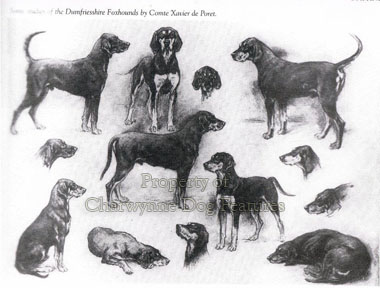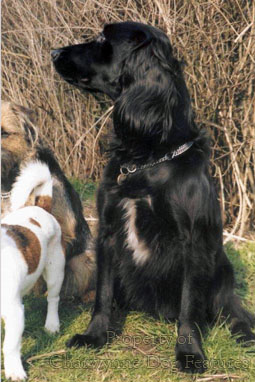207 Genetics & Hybrids
GETTING YOUR LINES CROSSED: GENETICS AND HYBRIDS
by David Hancock

 It is not unusual to see lurchers advertised for sale with a description of their breeding indicated by percentages. In this way for sale notices announce that a litter is on offer as: dam ¼ Deerhound ¾ Bedlington, sire ½ Greyhound ½ Beardie. There is a hint behind such an advertisement that the pups will reflect, each and every one of them, those percentages. But genes don't work like that. Such percentages are of interest but not directly of value to the future owner of one of these pups.
It is not unusual to see lurchers advertised for sale with a description of their breeding indicated by percentages. In this way for sale notices announce that a litter is on offer as: dam ¼ Deerhound ¾ Bedlington, sire ½ Greyhound ½ Beardie. There is a hint behind such an advertisement that the pups will reflect, each and every one of them, those percentages. But genes don't work like that. Such percentages are of interest but not directly of value to the future owner of one of these pups.
The pioneer Bullmastiff breeder, SE Moseley, recorded his formula for breeding as: "Taking a mastiff bitch and a bulldog I produce a 50/50. A bitch of these I mate to a mastiff dog and give me a 75% mastiff 25% bullbitch, which I mate to a 50/50 dog. A bitch from this litter is 62½% mastiff 37½% bulldog. I mate this to a 50/50 dog, and a bitch from this litter I put to a 62½% mastiff 37½% bulldog which gives me approximately my ideal 60% mastiff 40% bulldog."
Now read the words of Bateson in his 'The Progress of Genetic Research' as long ago as 1906: "...dogs, for example, derived from a cross a few generations back have been spoken of as 1/8 bulldog, or 1/32 pointer blood, and so forth. Such expressions are quite uncritical, for they neglect the fact that the characters may be transmitted separately and that an animal may have only 1/32 of the 'blood' of some progenitor, and yet be pure in one or more of its traits." Moseley was rather better at percentages than he was at genetics.
It is absurd to expect an individual dog from mixed breeding to reflect in looks and performance the percentages of blood in its genetic composition. It is ridiculous to expect each pup in a litter from mixed breeding to look and perform like its litter-mates. It is scientific nonsense to expect in a litter created by a mating in which 25% of the genes are Bedlington Terrier all the pups resulting to be 25% Bedlington either in looks or performance. There is a random nature to genes which must be taken into account. If you breed from good stock you stand a better chance of getting good offspring but it does not rule out the chance of getting the odd duffer.
It is difficult too to judge the success rate of a litter once mature. A potentially brilliant working dog can go to a completely useless trainer/handler. A much more limited dog can go to a really gifted trainer/handler and excel. Which represents the better breeding option? Both dogs come from the same genes. I am suspicious of claims made about one particular sire, one particular dam or one particular mating. We hear about successes not failures; most racehorses mated to big-time winners produce progeny which do not match their deeds. There is however a greater chance of producing winning horses from winning stock; bad luck if you get the one without the 'winning combination of genes'!
The hound expert Newton Rycroft made some interesting observations on heredity. He listed what he called 'genetic facts' which included: Light colours in the modern orthodox foxhound have more quality than the dark; the blue descendants of Carmarthen Nimrod 24 had better noses than the non-blue; the black hounds in the high quality Dumfriesshire kennel generally have more quality than the ones with more tan; a Greyhound-Bloodhound mating produced four pups, three looked like the Greyhound and had poor noses and the one that looked like a Bloodhound had an excellent nose; although black and yellow Labradors occur in the same litter, it is the blacks which have proved themselves much more successful in field trials.
When discussing these items he posed more questions than he gave answers. But geneticists have linked coat colour with certain skills and head shape is connected with scenting prowess. The American vet Whitney probably cross-bred more dogs than any other person, and produced more data as a result. One of his aims was to identify what was dominant genetically in the various inherited factors. He found (as did Stockard quite separately) that short legs are dominant over long. He showed that the presence of dew-claws on the hind legs was dominant over their absence. He found that greyhounds have a larger heart and liver than other breeds and pass this on.
Whitney found that a cross between the Bloodhound and the Bull Terrier had a far far greater resistance to distemper than either the Bloodhound and the Bloodhound X Great Danes in his kennel. His first and second crosses between breeds showed better disease resistance than the pure-bred dogs in his kennel. He recorded that the narrow pointed head of the sheepdog is dominant over the broader dished head of the Pointer, that the elongated head of the Greyhound was dominant over the short-faced Bulldog but that the latter was dominant over the Dobermann-type and usually dominant over the Basset hound head. He stated that a narrow chest is dominant over a broad chest, that a screw tail is not linked to the Bulldog head--as many believe still, and that the compact foot is usually dominant over the more open hare foot.
Against that background it would be a great benefit to our bank of knowledge if lurcher breeders were to keep detailed records of their breeding results, not just performance records but facts of genetic interest too. You don't have to be a highly-qualified scientist to notice genetic facts; Mendel, the father of modern genetics was not a scientist, but he observed what they could not. Someone like my namesake, the highly successful lurcher breeder, must have noted any manner of valuable points which no scientific experiment would have revealed. Cross breeding dogs can be much more informative than merely perpetuating a pure breed with a closed gene pool.
Cross-breeding to aid a pure breed, or out-crossing as it is known, is becoming less unthinkable for the more enlightened pedigree dog breeders. It is easy to overlook the fact that all our recognised breeds came to us from cross-breeding. It is often overlooked that the dog insurance companies charge a lower premium for cross-bred dogs than for pure-bred dogs, based on medical cost research. It is nearly always overlooked that covert cross-breeding gave the Rough Collie the Borzoi head and the show Border Collie its more profuse coat from the Rough Collie. It is conveniently forgotten that outcrosses to the Greyhound revitalized the Deerhound and that to the springer helped the Field Spaniel.
Now further outcrosses are being condoned. Some years ago an outcross from the Boxer to a Spitz breed was tried in order to produce erect ears. More recently Boxers have been crossed with corgis to obtain naturally docked tails. In Finland, pinschers and schnauzers are being crossed to widen the gene pool. They share common ancestors anyway. KC-registered Otterhounds however are unlikely to be outcrossed to the Welsh Foxhound as they might have been as pack members. In the USA, purpose-bred Assistance Dogs produce a 40% success rate from cross-bred dogs against 33% for pure-breds.
In-breeding is coming under greater scientific scrutiny as inheritable defects in pedigree dogs increase. Professional breeders of production animals such as cows, pigs, goats, sheep and horses consider that a coefficient of in-breeding of around 9% is risky. One researcher in America found that in dog breeds there is a decline in the average life span of around 7% for every 10% increase in in-breeding. Dwarfism has been found in Pointer litters at in-breeding coefficients of 13 to 37%, whereas unaffected litters rated 0 to 24%. In a Foxhound pack, the conception rate with sperm of in-bred dogs was 73% against 87% with out-bred ones; average litter size was 7 against 9 and 4 against 6 at weaning. The sperm count was 70 against 367.
Swedish pedigree dogs of 60 breeds had an average in-breeding coefficient of 14%. Why do breeders of production animals seek healthier animals than dog-breeders? The Germans have a new term for reckless breeding leading to discomfort, disease and a shorter life for the pedigree dog. It is 'qualzucht', cruelty breeding or more literally 'torture breeding'. The mainland European animal welfare organisations are homing in on such breeding and we would be well advised to heed this new interest. When a geneticist, himself in Boxers, finds it necessary to pose the question: Are there any Boxers that are truly free of heart murmurs? we have much to think about.